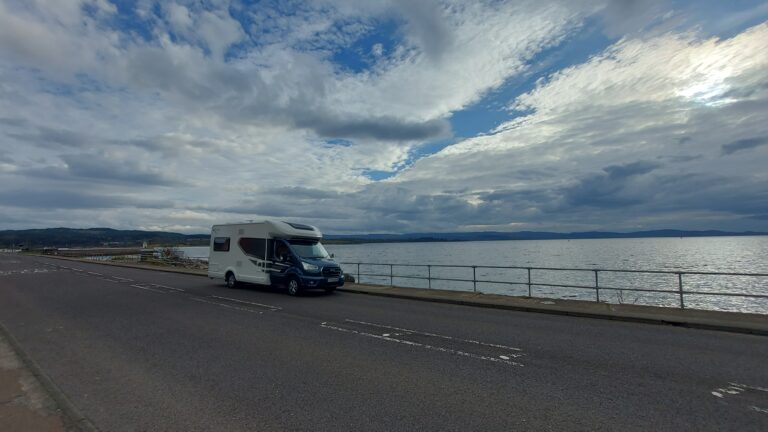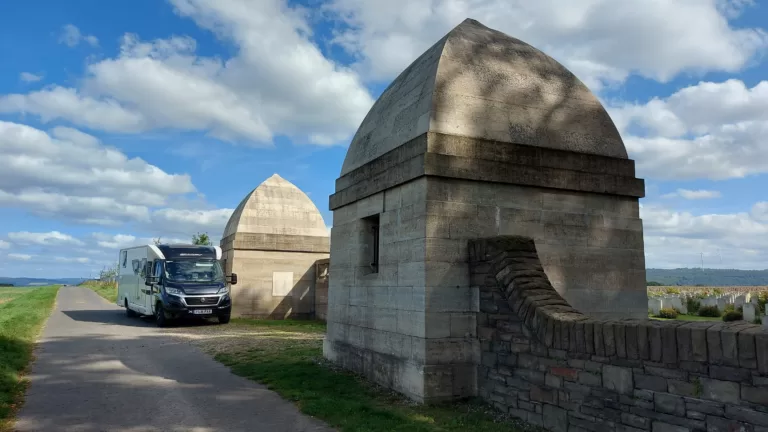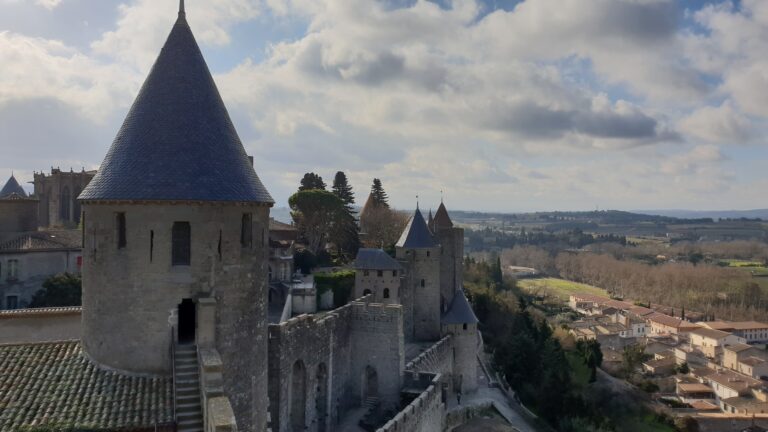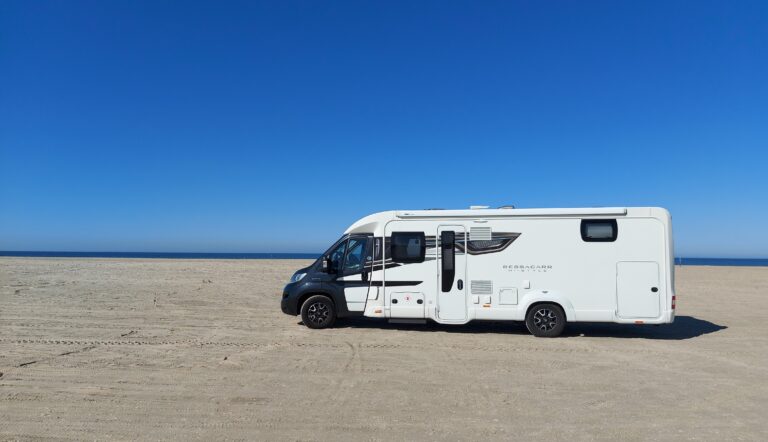ManVanNoPlan Visits Watten, Ypres & Langemark
ManVanNoPlan Visits Watten, Ypres & Langemark in the first blog of our 2022 Spring tour of Europe.
Wednesday 2nd of March In the last Blog we had just landed at Calais and we headed for Watten a village only a 35 minute drive away so really handy as a first/last stop for the ferry/tunnel.
We hadn’t stayed anywhere near Calais in years, especially since the migrant problems began but the town of Watten was sufficiently far enough away from any issues. Anyway, any migrant would have a problem if they clung on to the underside of Bessie given this was the first day of a three month tour heading away from Calais!

The Aire in Watten sits on the bank of a wide canal, the canal de la Haute Colme, where fairly large barges ply their trade. A duck pond is immediately behind us with the smaller river Aa behind that. The Aire takes about fifteen motorhomes and is FREE to park and a € 4 jeton can be bought at a nearby tobacconists to get 10 minutes of water and 55 minutes of power with dumping of grey and black water free at any time.



Fyne Editions had a record November and December and I have big plans to expand the listings, especially of diaries and notebooks and this is what has kept me busy throughout the first quarter of 2022 and hundreds of new listings have been added so check out Fyne Editions HERE. The series below is new for 2022 and features titles from 1940 to 2014 and they make great birthday presents as a £ 4.99, 101 page notebook is far better value than a birthday card that will probably be binned after a week or so! Click the nationality of your choice to see the full range…
“The village is famous for its old ruined abbey, and for its mill, which was restored in the 1990s. These two buildings are located on the “Mountain of Watten” (72 metres high). Its church dates from the thirteenth century.
Nearby is the Blockhaus d’Éperlecques, a massive German bunker site from World War Two, wrecked by Allied bombing. It is now a museum.”
There was one fellow Brit on the Aire when we arrived, Keith, a Welshman who was living in his motorhome full time and he had been here a few weeks, and why not. Forty five minutes from Calais, a lovely village to walk around and a Netto supermarket two hundred yards away with free official parking. Entertainment is provided by the huge cargo barges going up and down the river a few yards in front of us.
We had departed Canterbury, crossed the Channel and arrived in Watten just on 10am UK time so we relaxed and after lunch, with the rain just spitting now instead of pouring we ventured out to have a walk up the main street and into the very ornate church a few yards from the main street. We had seen a notice in quite a few shop windows advertising a bus trip to Lourdes in the Pyrenees taking 10 days and costing € 600 each. The church had a shrine and many souvenir plaques from Lourdes so it must be a long standing association with that place of pilgrimage.


Speaking of pilgrimages there was a poster in the entrance to the church advertising even more trips of a religious nature to all over Europe including one to Scotland in September. Who knew?
Thursday 3rd of March 2022
Netto, the Danish discount supermarket, (owned by Asda in the UK) is only a couple of hundred yards from the Aire so this morning’s activity was a walk to see what was on offer there. We did get a few things including our first baguette of the trip but I can’t say I was impressed by this Netto store but it served a purpose for us today. The one bonus for future reference is that it has a laundry on site.

Yesterday The Navigator purchased a jeton for the Bourne so as the Aire was quiet I drove onto the service area and we drained the waste water, filled up with fresh water, emptied the toilet, washed the cab and when all of this was happening I connected the electricity cable to the Bourne for our 55 minute of electricity. Keith, who more or less stays on this site for as long as his Shengen time allows, is good company and we chatted to him for ages and he seemed genuinely grateful when I gave him a Scottish gift. Does a can of sugar free Irn Bru count as a gift?

Fyne Editions has a great NEW range of gift notebooks for anyone celebrating a wedding anniversary. Our titles cover all the special anniversary dates and we have also configured the same years with the UK special anniversary meanings so we have a FIRST wedding anniversary as shown and a corresponding PAPER wedding anniversary title right through to SIXTIETH and DIAMOND wedding anniversary. Click the image above to see the full range.
The jacket shown on the left is just one of a range of notebook titles celebrating the specific year a couple were married and we have configured titles from 1960 through to 2021.
Why not send your relative, friends or colleague a notebook instead of a card which will probably be discarded in a week or so and the bonus is that every time they use it they will think of the person who sent it! Click the image above to see the full range.
After lunch The Navigator was determined to climb the mountain which overlooks the village to see the site of the former fortifications, a windmill and an abbey. It is described locally as a mountain but at 182 feet above sea level it is maybe best described as a steep hill. We made it up a slippery grass path and were puggled and glad of the seat at the top facing north all the way to Dunkirk on the coast. A highlight for me was seeing two TGF trains speed past at the top of the village.
Le Moulin de Watten was suitably impressive for such an ancient structure but the Abbey and grounds were closed.


On the way back through the village we stopped at the local patisserie and treated ourselves to a sort of lemon meringue pastry which we had with a well deserved cuppa in the van.
There are many historical pictures on boards around the village which were interesting to see. They seemed to be scanned from old postcards with the stamps mostly on the front picture side. Also not far from the village in a nearby woods is a well preserved V2 rocket site from WW2 but time did not permit on this occasion as we are off to Belgium in the morning.
Watten – GPS = 50.831187, 2.208641 & What3Words = ///homeward.faithfully.doddle
Friday 4th of March 2022
The plan, if there is such a thing, is to stay two nights in any one place. So arrive, spend the night and have a full day to explore the location and move on the next day. That’s the theory anyway so after two nights in Watten it was time to say our goodbyes to Keith, our new Welsh chum and move on into Belgium. It would take around an hour to drive to Ypres but before that we headed a few miles south to St Omer to a fairly large and well stocked Aldi.
This was to check out the price and quality of their wine as we may stock up on the way back to the UK in late May. They had two white wines at € 1.99 so bought one of each to try them out. As I was paying for them The Navigator went across the the street to a Lidl for some Nems, which if you have not heard of before are a sort of Vietnamese spring roll which are delicious.

From St Omer the satnav took us through a very flat landscape of fields with no fences and consequently no cows or sheep. We went through a few lovely villages and one massive town which we had never heard of before, Bailleul, and it looked to be worth exploring the next time in this area.
The border into Belgium was a non event marked by only the customary blue sign with the EU stars and an old bloke with a wheelbarrow! We arrived at the campsite in Ypres just on noon and negotiated the automated machine to check in which seemed to ask for every detail apart from my inside leg measurement!

The price per night at Camping Jeugdstdion in Ypres is €16 (£13.32) which includes electricity and all facilities. We had been here back in November 2011 so knew what to expect.




Ypres, or Leper as its called on all the Belgium road signs is a really beautiful historic large town totally rebuilt brick by brick after being flattened during the First World War. This next picture shows the Flanders Field Museum with the Cathedral behind it in the centre.

“Ypres (leper), is a town in the Belgian province of West Flanders. It’s surrounded by the Ypres Salient battlefields, where many cemeteries, memorials and war museums honour the battles that unfolded in this area during World War I. After being destroyed in the war, many important buildings were carefully reconstructed, including Gothic-style Sint-Maartenskathedraal (St. Martin’s Cathedral) and its soaring spire.”


It was a lovely sunny day so after lunch we walked the short distance into the town centre and wandered about for most of the afternoon. Being Belgium every second shop seemed to be either selling chocolates or beer and the streets were colourfully displaying cycling jerseys for races coming to the town later in the month. What most people, especially the British, come to Ypres for is to see and marvel at the Menin Gate.
“The Menin Gate is one of four memorials to the missing in Belgian Flanders which cover the area known as the Ypres Salient. Broadly speaking, the Salient stretched from Langemarck in the north to the northern edge in Ploegsteert Wood in the south, but it varied in area and shape throughout the war.
The Salient was formed during the First Battle of Ypres in October and November 1914, when a small British Expeditionary Force succeeded in securing the town before the onset of winter, pushing the German forces back to the Passchendaele Ridge. The Second Battle of Ypres began in April 1915 when the Germans released poison gas into the Allied lines north of Ypres. This was the first time gas had been used by either side and the violence of the attack forced an Allied withdrawal and a shortening of the line of defence.
There was little more significant activity on this front until 1917, when in the Third Battle of Ypres an offensive was mounted by Commonwealth forces to divert German attention from a weakened French front further south. The initial attempt in June to dislodge the Germans from the Messines Ridge was a complete success, but the main assault north-eastward, which began at the end of July, quickly became a dogged struggle against determined opposition and the rapidly deteriorating weather. The campaign finally came to a close in November with the capture of Passchendaele.
The German offensive of March 1918 met with some initial success, but was eventually checked and repulsed in a combined effort by the Allies in September.
The battles of the Ypres Salient claimed many lives on both sides and it quickly became clear that the commemoration of members of the Commonwealth forces with no known grave would have to be divided between several different sites.
The site of the Menin Gate was chosen because of the hundreds of thousands of men who passed through it on their way to the battlefields. It commemorates casualties from the forces of Australia, Canada, India, South Africa and United Kingdom who died in the Salient.
The Ypres (Menin Gate) Memorial now bears the names of more than 54,000 officers and men whose graves are not known.”



There are dozens of First World War cemeteries, all beautifully maintained by The War Graves Commission but the Menin Gate is the focal point of the remembrance of those brave men from all over the world who fought for our freedom here. There are 54,000 names on this memorial and those are just the ones who have no known grave.
CHECK OUT THE BORN & BRED IN... NOTEBOOK RANGE
We rounded off our afternoon with a coffee (The Navigator) and a blonde Belgian beer (Moi) in the Ypra Inn right beside the Menin Gate.
Saturday 5th of March 2022
Today’s plan of action was to get up and away sharpish as Saturday is market day in Ypres and a continental market is always worth visiting and it certainly didn’t disappoint, the highlight being a massive truck selling rotisserie chicken, racks of ribs and lots more besides. It was so busy it needed six people serving and still there were queues. Very few markets will have such ornate buildings as a backdrop and this other picture shows a very high tech 40 foot lorry selling every type of fish and seafood imaginable.


Apart from the market we walked around the outside of the massive St Martin’s Cathedral but it was closed due to the road and pavements outside being dug up, it would have been free as well which would have pleased The Navigator!
We returned to the market before we left the town centre and bought some chicken and half a rack of ribs which was reheated back at Bessie for lunch. Delicious. The afternoon was spent relaxing watching as the site filled up with Belgian motorhomes and a few caravans as well. I finished off the last blog as we are hooked up to power for the laptop.
After dinner we wrapped up against the elements as it was bitterly cold and headed down to the Menin Gate to watch the ceremony at 8pm commemorating the Allied dead of WW1. You can gauge the scale of this monument when you see how tiny The Navigator looks on the left of the picture.

“From 11 November 1929 the Last Post has been sounded at the Menin Gate Memorial every night and in all weathers. The only exception to this was during the four years of the German occupation of Ypres from 20 May 1940 to 6 September 1944. The daily ceremony was instead continued in England at Brookwood Military Cemetery, Surrey. On the very evening that Polish forces liberated Ypres the ceremony was resumed at the Menin Gate, in spite of the heavy fighting still going on in other parts of the town. Bullet marks can still be seen on the memorial from that time.”
“At 7.30pm the police arrive and all traffic is stopped from driving through the Menin Gate Memorial. For a short time each day the noise of traffic echoing around the Menin Gate from the cobbled road ceases. The crowd is hushed. A stillness descends over the memorial.
At 7.55pm Buglers of the local volunteer Fire Brigade arrive and stand ready at the eastern entrance of the Menin Gate Memorial.
The Buglers then step into the roadway under the memorial arch and make their way to stand in the centre of the Hall of Memory. The Buglers stand in a line across the eastern entrance facing towards the town. It is a solemn, dignified event and all those attending are respectfully requested not to clap at the end of the proceedings.
A volunteer from the Last Post Association standing in the centre of the road under the arch of the Hall of Memory recites these words:
“They shall grow not old, as we that are left grow old:
Age shall not weary them, nor the years condemn.
At the going down of the sun and in the morning,
We will remember them.”
At 8pm exactly there is a call to Attention by the buglers of the Last Post Association. They then sound the “Last Post” bugle call followed by a minute of silence and they then play the “Réveille” bugle call which marks the end of the ceremony.”




Ypres – GPS = 50.846840, 2.897651 & What3Words = ///slowly.pimples.skinny
Sunday 6th of March 2022
We moved on this morning but only 9km to Langemark just to the north of Ypres. Why only a few kilometres I hear you say as one. Well we have somewhere to be on Tuesday and as it is one of the more expensive Aire in Belgium, we are marking time, with a purpose though as you will now see…
As I mentioned above this whole area of Belgium has dozens of WW1 graveyards and monuments and we decided to have a look at some more before moving on to a new region. My grandfather was wounded and captured at the Battle of Loos near Lille, 45 minutes south of Ypres and we have been to see the battlefield a few years ago in our previous motorhome. On this trip we wanted to see a few more memorials to the north of Ypres plus it was in our general direction anyway.
After leaving the Ypres campsite we drove for less than 10 minutes into the middle of a huge industrial estate and this being Sunday it was really quiet so could park easily at the Yorkshire Trench & Dugouts.
In 1992 a group of amateur archeologists named “The Diggers” first discovered the remains of an original British trench. Between 1998 and 2000 they spent many hours digging and examining the trench, which also had tunnelled dugouts. At the time major construction work for new buildings in Ypres’ northern industrial zone was also being carried out.
In addition to many artefacts “The Diggers” discovered the remains of 155 First World War soldiers. The casualties they discovered were British, French and German, lost in battle and never recovered for seventy years.
The project to unearth the trench section featured in a BBC television documentary called “The Forgotten Battlefield”. The soldiers’ remains and items found during the dig were passed over to the Commonwealth War Graves Commission (CWGC), the German war graves commission (the Volksbund Deutsche Kriegsgräberfürsorge) and the French Embassy. The museums of In Flanders Fields in Ieper and the Hooghe museum on the Menin Road received some of the artefacts for their archive collections. The remains of the 155 casualties were reburied with full military honours in military cemeteries.




From there we drove a few minutes to the Welsh Memorial Park near Langemark.
The Welsh National Memorial Park is a war memorial in Langemark near Ypres for soldiers of World War I, located near the Pilkem Ridge in the former Ypres Salient. It commemorates the services of men and women from Welsh origin, wherever they served during the Great War as part of the Allied Powers, as well as the non-Welsh soldiers serving in Welsh formations.

Less than 2 minutes further on is our Aire for the next 2 nights beside the Langemark Sports Hall. It is a proper little Aire and has power and water for 12 euro a night. There was one other motorhome in situ when we arrived and they were bravely sitting outside having a drink. It may have been sunny but the wind chill took the temperature down to just above freezing.
We wrapped up and had a walk into Langemark which, being Sunday, was deserted but it looked a very well looked after village. Back at the van later I wrote up most of this blog then we settled down for an evening of YouTube videos on the TV with the heating on all night.





Monday 7th of March 2022
As expected we awoke to a bright, sunny, but frosty morning. I was keen to try out my new bike and managed to convince The Navigator that we should visit a few of the local landmarks. It was incredibly cold but we set off none the less.
First stop was to the Cement House Cemetery which was only a few hundred yards back the way we had come and fairly close to the Welsh Memorial we visited yesterday.
“Langemark has given its name to the Battles of 21-24 October 1914 and 16-18 August 1917. The village was in German hands from April 1915 to August 1917 and from April to September 1918. Commonwealth, French and Belgian forces have in turn defended and attacked it.
“Cement House” was the military name given to a fortified farm building on the Langemark-Boesinghe (now Boezinge) road. The original Cement House Cemetery (now Plot I, an irregular group of 231 graves) was begun here at the end of August 1917 and used by the 4th and 17th Division burial officers, by field ambulances and by units in the line until April 1918. There are now 3,592 Commonwealth servicemen of the First World War buried or commemorated in the cemetery, 2,425 of the burials are unidentified.”
This was the first time I had seen a single headstone containing three or four graves of unidentified soldiers, although a few al least had the regiment they belonged to.



From the Cement House Cemetery we cycled back through the village to the other side and another monument, the Poppy Monument. The wind was against us this time and our hands in particular were freezing cold.
“In September 2016, a striking new World War 1 Peace Monument was created at the Grote Markt, in front of the In Flanders Fields Museum in Ypres, Belgium and is now located adjacent to the German War Cemetery at Langemark Poelkapelle.
Standing 7m tall and weighing 12 tonne, the metal Peace Monument for the 21st century features the evocative image of a single Flanders poppy surrounded by a field of 2016 steel poppies handcrafted by blacksmiths and farriers worldwide.”
The Poppy Memorial borders The German Cemetery and the contrast between this one and a Commonwealth Cemetery is obvious to see as the German Cemetery is a mass grave with some 44,000 men buried in this one site alone and there are no individual headstones, even for the men who were identified. They were brought here from lots of smaller cemeteries around this area after the war.


With the wind behind us we cycled back into the village and bought a few supplies before heading back to Bessie and the heating on again…
At least it’s dry!
COMING SOON ON THE NEXT BLOG...
We head to Bruges, or is it Brugges? This will be the third or fourth time and we never tire of visiting this beautiful city.




















